
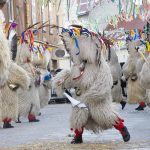
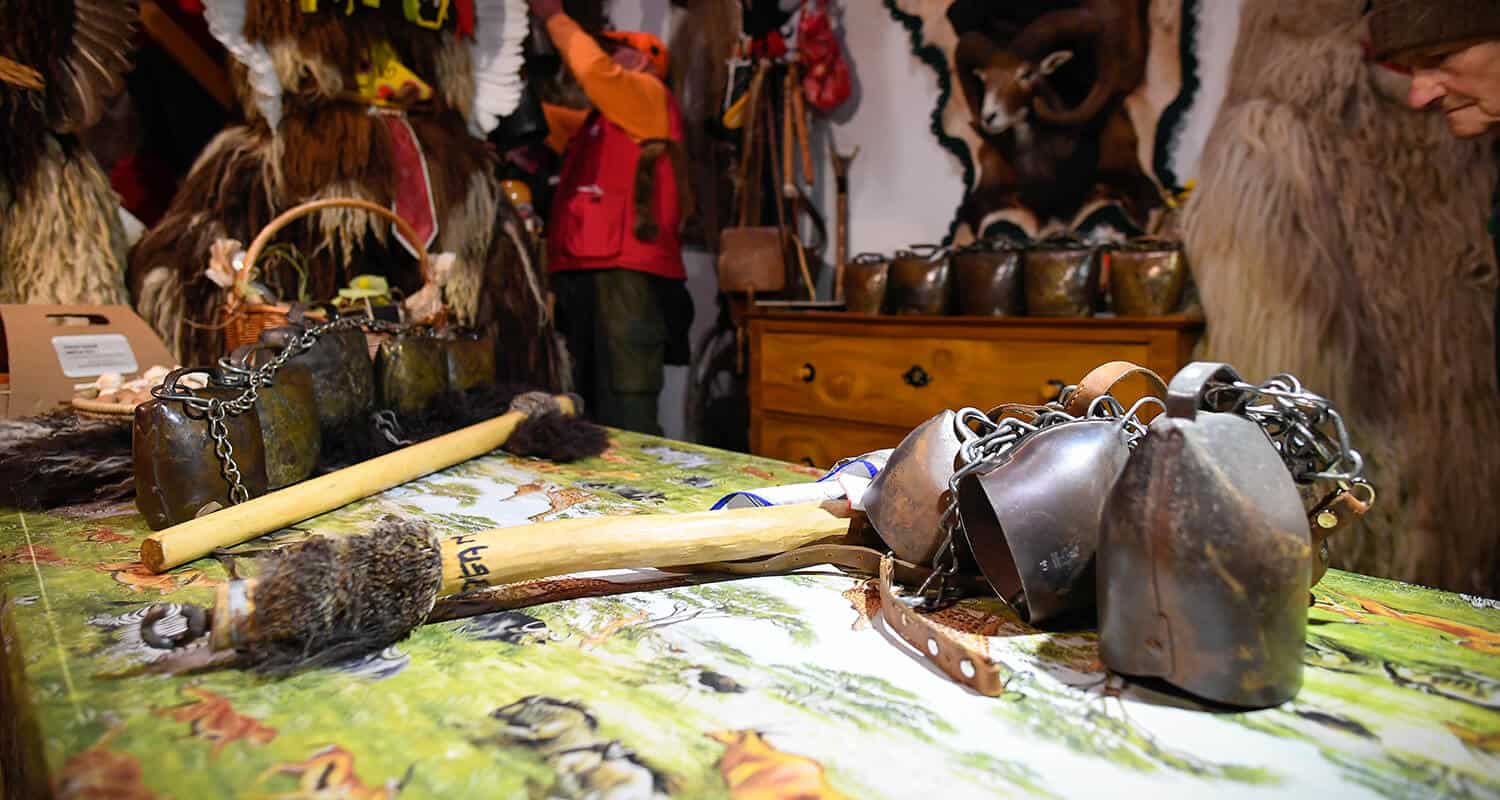
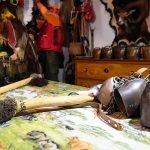

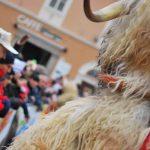
Kurent/Korant
Kurent or Korant is the best known and most popular traditional carnival character in Slovenia. On the conceptual and spiritual level, it is much more than a symbol of Ptuj and Slovenia. Its origins are rather mysterious and shrouded in centuries of secrecy. It has been associated with Slavic, Illyrian, Celtic and Greek and Roman mythology. Kurent’s mission can be traced to the symbolism of natural phenomena, the anticipation of spring and Ancient Roman rituals resembling Carnival traditions. Kurent’s season symbolically comes between two Christian holidays – Candlemas and Ash Wednesday. No matter where we look for the roots of this figure from Ptujsko-Dravsko Polje, Haloze and Slovenske Gorice, we will find lore similar to the one carried by the Kurent. According to tradition, Kurents drive away evil and bring better times to the land, be it in the form of prosperity, warm spring or abundant harvest.
Images of the Kurent can be found in corporate images of companies, and public and civil society organizations. Famous Slovenian painter and graphic artist France Mihelič gave his own original interpretation of the Kurent, making it the main iconographic symbol in his fantastic art.



Kurent or Korant is the best known and most popular traditional carnival character in Slovenia. On the conceptual and spiritual level, it is much more than a symbol of Ptuj and Slovenia. Its origins are rather mysterious and shrouded in centuries of secrecy. It has been associated with Slavic, Illyrian, Celtic and Greek and Roman mythology. Kurent’s mission can be traced to the symbolism of natural phenomena, the anticipation of spring and Ancient Roman rituals resembling Carnival traditions. Kurent’s season symbolically comes between two Christian holidays – Candlemas and Ash Wednesday. No matter where we look for the roots of this figure from Ptujsko-Dravsko Polje, Haloze and Slovenske Gorice, we will find lore similar to the one carried by the Kurent. According to tradition, Kurents drive away evil and bring better times to the land, be it in the form of prosperity, warm spring or abundant harvest.
Images of the Kurent can be found in corporate images of companies, and public and civil society organizations. Famous Slovenian painter and graphic artist France Mihelič gave his own original interpretation of the Kurent, making it the main iconographic symbol in his fantastic art.
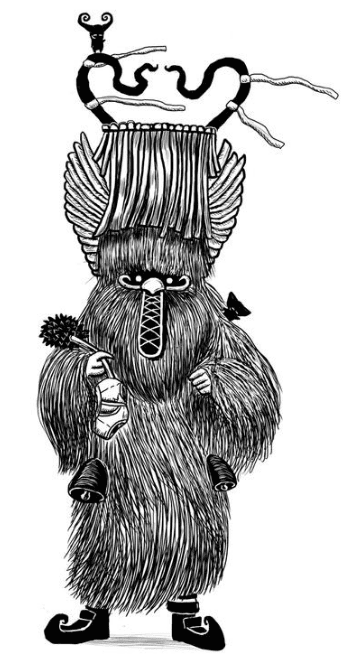
Only young men could dress as Kurents in the past. Between Candlemas on 2 February and Ash Wednesday, groups of Kurents walked through their home and neighboring villages in the company of the devil, who stole a sausage or two from the house. Their visit brought luck to the house in the coming year. If Kurents rolled themselves on the ground on the homestead’s yard, that brought a year of bad luck. In the second half of the 20th century, they started frequenting Ptuj in greater numbers, and making appearances at Kurentovanje and other organized carnival and folk events in Slovenia and abroad.
Today, about a thousand of Kurents form a number of village and town groups – most of them are young men, but some young women joined them in recent times. Only a few artisans know how to make Kurentija – Kurent’s costume. Although the costumes are pricey, the number of orders keeps increasing through years, proving the growing popularity of Kurent’s heritage.
Artwork: Luka Oman

Only young men could dress as Kurents in the past. Between Candlemas on 2 February and Ash Wednesday, groups of Kurents walked through their home and neighboring villages in the company of the devil, who stole a sausage or two from the house. Their visit brought luck to the house in the coming year. If Kurents rolled themselves on the ground on the homestead’s yard, that brought a year of bad luck. In the second half of the 20th century, they started frequenting Ptuj in greater numbers, and making appearances at Kurentovanje and other organized carnival and folk events in Slovenia and abroad.
Today, about a thousand of Kurents form a number of village and town groups – most of them are young men, but some young women joined them in recent times. Only a few artisans know how to make Kurentija – Kurent’s costume. Although the costumes are pricey, the number of orders keeps increasing through years, proving the growing popularity of Kurent’s heritage.
Kurents’ Door-to-Door Rounds on Prestigious Unesco List
Great recognition from Unesco
Kurent - the most popular carnival character
UNESCO (United Nations Educational, Scientific and Cultural Organization) added door-to-door rounds of Kurents/Korants to its Representative List of the Intangible Cultural Heritage of Humanity in 2017. Entry on Unesco’s list is certainly extremely important, not only for preserving the regional ethnographic heritage, but also for raising Ptuj’s international profile. Nowhere else in Slovenia or wider you will find such a diversity of traditional folk carnival characters, however Kurent still occupies the central role among them. The fact that the biggest open event in the country (Kurentovanje) is named after this character speaks for itself.
Masks are so widely spread that they hold a significant place in the history of the mankind. For centuries people have believed that the use of masks could help to make connections with the world beyond, with demons, gods, and ancestors’ spirits. Their driving force was to understand and influence natural and social phenomena. The celebration of the carnival goes back to the pagan period, before Christianity, when people celebrated the forthcoming spring and the inevitable end of the winter by performing the rituals of fertility and by magic of masks. Although later Christianity felt absolutely disinclined to this pagan performance, it could never really uproot the masquerading. To be preserved the carnival took place at the beginning of the 40-day Lent preceding Easter; in fact Lent lasts 46 days as the first day is Ash Wednesday. After the period of merry-making, excessive eating and drinking which end on Shrove Tuesday at midnight, begins the period of fasting.
Masks and masquerading which have come into existence through various historical periods, can nowadays be divided into traditional masks with magic power, and contemporary carnival masks criticising and mocking different events happening in everyday life. In Slovenia, the Ptuj and Drava Fields, Haloze and Slovenske Gorice hills represent the area which deserves special attention for the number and variety of traditional carnival masks.
Public institution Ptuj
Organizer of Kurentovanje
Mestni trg 4,
SI-2250 Ptuj
T: +386 (0) 2 779 60 11
pr@kurentovanje.net
info@kurentovanje.net
Kurentovanje
We firmly believe that the internet should be available and accessible to anyone, and are committed to providing a website that is accessible to the widest possible audience, regardless of circumstance and ability.
To fulfill this, we aim to adhere as strictly as possible to the World Wide Web Consortium's (W3C) Web Content Accessibility Guidelines 2.1 (WCAG 2.1) at the AA level. These guidelines explain how to make web content accessible to people with a wide array of disabilities. Complying with those guidelines helps us ensure that the website is accessible to all people: blind people, people with motor impairments, visual impairment, cognitive disabilities, and more.
This website uses various technologies that are meant to make it as accessible as possible at all times. We utilize an accessibility interface that allows persons with specific disabilities to adjust the website's UI (user interface) and design it to their personal needs.
Additionally, the website utilizes an AI-based application that runs in the background and optimizes its accessibility level constantly. This application remediates the website's HTML, adapts its functionality and behavior for screen-readers used by blind users, and for keyboard functions used by individuals with motor impairments.
If you've found a malfunction or have ideas for improvement, we'll be happy to hear from you. You can reach out to the website's operators by using the following email
Our website implements the ARIA attributes (Accessible Rich Internet Applications) technique, alongside various different behavioral changes, to ensure blind users visiting with screen-readers are able to read, understand, and enjoy the website's functions. As soon as a user with a screen-reader enters your site, they immediately receive a prompt to enter the Screen-Reader Profile so they can browse and operate your site effectively. Here's how our website covers some of the most important screen-reader requirements, alongside console screenshots of code examples:
Screen-reader optimization: we run a background process that learns the website's components from top to bottom, to ensure ongoing compliance even when updating the website. In this process, we provide screen-readers with meaningful data using the ARIA set of attributes. For example, we provide accurate form labels; descriptions for actionable icons (social media icons, search icons, cart icons, etc.); validation guidance for form inputs; element roles such as buttons, menus, modal dialogues (popups), and others. Additionally, the background process scans all the website's images and provides an accurate and meaningful image-object-recognition-based description as an ALT (alternate text) tag for images that are not described. It will also extract texts that are embedded within the image, using an OCR (optical character recognition) technology. To turn on screen-reader adjustments at any time, users only need to press the Alt+1 keyboard combination. Screen-reader users also get automatic announcements to turn the Screen-reader mode on as soon as they enter the website.
These adjustments are compatible with all popular screen readers, including JAWS and NVDA.
Keyboard navigation optimization: The background process also adjusts the website's HTML, and adds various behaviors using JavaScript code to make the website operable by the keyboard. This includes the ability to navigate the website using the Tab and Shift+Tab keys, operate dropdowns with the arrow keys, close them with Esc, trigger buttons and links using the Enter key, navigate between radio and checkbox elements using the arrow keys, and fill them in with the Spacebar or Enter key. Additionally, keyboard users will find quick-navigation and content-skip menus, available at any time by clicking Alt+1, or as the first elements of the site while navigating with the keyboard. The background process also handles triggered popups by moving the keyboard focus towards them as soon as they appear, and not allowing the focus to drift outside it.
Users can also use shortcuts such as "M" (menus), "H" (headings), "F" (forms), "B" (buttons), and "G" (graphics) to jump to specific elements.
We aim to support the widest array of browsers and assistive technologies as possible, so our users can choose the best fitting tools for them, with as few limitations as possible. Therefore, we have worked very hard to be able to support all major systems that comprise over 95% of the user market share including Google Chrome, Mozilla Firefox, Apple Safari, Opera and Microsoft Edge, JAWS and NVDA (screen readers).
Despite our very best efforts to allow anyone to adjust the website to their needs. There may still be pages or sections that are not fully accessible, are in the process of becoming accessible, or are lacking an adequate technological solution to make them accessible. Still, we are continuously improving our accessibility, adding, updating and improving its options and features, and developing and adopting new technologies. All this is meant to reach the optimal level of accessibility, following technological advancements. For any assistance, please reach out to